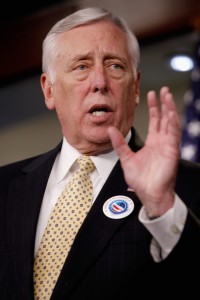 Washington, D.C. – Congressman Steny H. Hoyer (MD-5) delivered a speech today on the role of manufacturing in building a strong and competitive economy. He also announced a new list of bills as part of the Democrats’ Make It In America plan, which combines business tax reforms with strategic investments in education, technology and infrastructure to enable manufacturers to expand operations and add jobs. Ultimately, the goal of Make It In America is to maintain the United States’ economy as the strongest in the world.
Washington, D.C. – Congressman Steny H. Hoyer (MD-5) delivered a speech today on the role of manufacturing in building a strong and competitive economy. He also announced a new list of bills as part of the Democrats’ Make It In America plan, which combines business tax reforms with strategic investments in education, technology and infrastructure to enable manufacturers to expand operations and add jobs. Ultimately, the goal of Make It In America is to maintain the United States’ economy as the strongest in the world.
Below, you will find Congressman Hoyer’s inspiring address in its entirety.
“As he prepared to take office, President Kennedy spoke to a nation troubled by anxiety over America’s leadership in the world and uncertainty over whether future Americans would inherit a strong and secure economy.
“He offered not soothing words but a rousing appeal and an exhortation to action. He spoke to his generation of Americans and urged them not to shrink from their responsibility to advance across a New Frontier of science and of commerce.
“Today, we confront similar anxiety but much greater global competition. It is, therefore, essential for us to seize the initiative in education, in innovation, in technology, in alternative energy, and in advanced manufacturing.
“Once again, our leaders must ensure that America’s role in the world is secure, that our economy will remain the strongest on Earth, and that Americans will continue to find good jobs and have confidence that they can and will ‘Make It In America.’
“The key to success, I believe, is a renewed dedication to the kind of individual effort and personal responsibility and commitment that made this country great.
“America’s history has been one of inventing, innovating, and developing better products, processes, and services. It has been a history in which manufacturing goods has played a major role. And Americans overwhelmingly believe that making things in America must be an important part of our future.
“Manufacturing has been a bright star of our recovery. Over the last three years, we’ve seen strong gains by manufacturers. We have witnessed twenty-eight consecutive months of private sector job growth, and manufacturing has added half a million jobs since January 2010.
“Productivity increased 5.9 percent in the first quarter of 2012. Industrial production, as measured by the Federal Reserve’s Industrial Production Index for Manufacturing, has surged 20% from its lowest point in June 2009. Factory orders were up 0.7 percent in May from the previous month, signaling new investment.
“Manufacturing is also driving a rise in U.S. exports. In the first four months of this year, total U.S. goods and services exports were up 6% – or $41.4 billion – from the same period last year. In that same time, manufacturing exports were up 9.1%.
“After having watched for years as American manufacturing jobs were shipped overseas, we are now bearing witness to some of these jobs returning. Companies are recognizing the rising costs of production in other countries and are looking once again to the talent and experience of American workers.
“Last month, Google announced a new home media device that is being manufactured only a few miles from its headquarters in California. Asked why the company chose to make it here in America, Google representatives cited, among several reasons, the benefit of its engineers being able to travel easily between the design lab and the production line.
“Airbus has said it will begin construction on its first U.S. manufacturing plant next year in Alabama. That $600 million facility will support a thousand new jobs. Over the past two years, other businesses have chosen American workers to manufacture their products, including Caterpillar, NCR, and Ford.
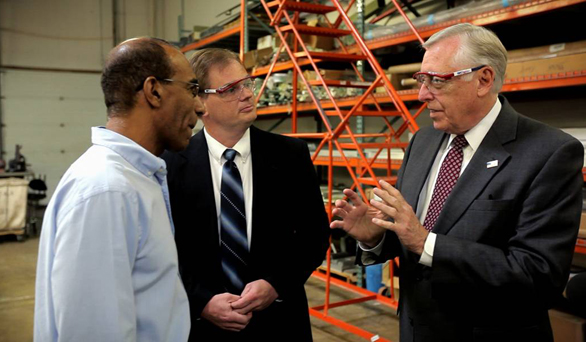
Democratic Whip Steny Hoyer (MD-5) visits Maryland manufacturer Antenna Research Associates, Inc. to discuss ‘Make It In America.’ (June 2011)
“However, despite these recent gains, Americans are still worried about our economy, unsure whether our recovery will continue. Uncertainty over consumer demand hangs like a dark cloud over manufacturing’s bright horizon. Americans are also looking with great concern to the financial crisis that continues to plague Europe and hope it does not spread.
“But now is not a time to hunker down; it is most definitely a time to go on offense.
“As President Obama declared in his State of the Union Address this January, ‘We have a huge opportunity, at this moment, to bring manufacturing back. But we have to seize it. …It’s time to stop rewarding businesses that ship jobs overseas and start rewarding companies that create jobs right here in America.’
“He’s right. This is our moment to pursue policies that capitalize on what we’ve achieved in manufacturing so far in order to make certain the positive trends in our recovery continue. We must make a strong and serious effort to create an environment that grows the manufacturing sector so companies can hire for jobs that will stay here.
“In the meantime, our overseas competitors are doubling down on investments in their own workforces, in innovation, and in providing the tools that nurture manufacturing growth. Not only are other countries surging ahead in the number of engineers and scientists they graduate, but they are pouring money into basic research and technology development.
“The National Science Board reported earlier this year that China and nine other countries have increased their research and development spending to match ours.
“In the wealthiest country in the world, we will lose only if we fail to invest in the priorities of success. We have seen the manufacturing sector help our recovery gain momentum, but we know that’s not enough. Congress must pass a comprehensive jobs plan that invests in the advanced manufacturing and innovation that is critical to our future.
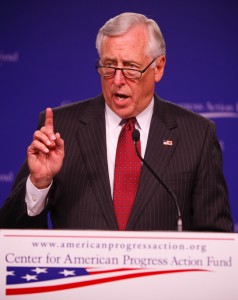 “Two years ago, Democrats introduced such a plan. It’s called Make It In America. The premise is simple: if we can help manufacturers ‘make it’ in America, it will help more of our people ‘Make It In America.’
“Two years ago, Democrats introduced such a plan. It’s called Make It In America. The premise is simple: if we can help manufacturers ‘make it’ in America, it will help more of our people ‘Make It In America.’
“Make It In America combines business tax reforms that encourage manufacturers to bring jobs back with strategic investments in education, job training, innovation, green energy technology, and infrastructure. Under Make It In America, businesses would be enabled to base decisions not on the best tax outcome but more importantly economic outcomes. Quite simply, business judgments, not tax judgments.
“Our plan has also recognized that our current system of taxation is too complex, and there is a growing consensus that we should lower rates, broaden the base, close loopholes, and maintain revenue levels. Businesses will make things in America only if they can do so profitably.
“We must also address regulation. In his State of the Union Address in January, President Obama called for smarter regulations that will keep Americans safe and help businesses grow. He said – and I quote: ‘Most new jobs are created in start-ups and small businesses. So let’s pass an agenda that helps them succeed. Tear down regulations that prevent aspiring entrepreneurs from getting the financing to grow.’ And, I would add, simplify needed regulations to ensure protection of consumers and competitors without impeding growth and investment.
“But addressing taxes and regulation alone won’t do it. Again and again, we’ve heard from manufacturers looking to invest here that they simply cannot find enough workers with the skills and training they need in engineering and advanced machine operations. We need to ensure that Americans have the skills and knowledge to perform the jobs created by advanced manufacturing enterprises.
“Furthermore, our economy will benefit from the enactment of comprehensive immigration reform that helps us attract and retain talent here and invests in the strengths of our immigrant entrepreneurs seeking to ‘Make It In America.’ Rejecting the most skilled and able from our shores is neither consistent with our tradition of welcoming those who wish to help make America great nor rational in our efforts to compete in a global marketplace.
“Make It In America is the comprehensive jobs plan our country needs. It draws on the best ideas from both parties and has won praise from both business and labor. And we’ve already had some success, with ten MIIA bills signed into law, including the America COMPETES Act to strengthen science and math education, the America Invents Act that achieved long-overdue patent reform, and a reauthorization of the Small Business Innovation Research and Small Business Technology Transfer programs.
“The two parties also worked together to pass the Jumpstart Our Business Start-Ups Act, a bipartisan legislative package that included a number of proposals from our Make It In America agenda.
“But just last week, the Institute of Supply Management reported that June was the first month that the manufacturing sector contracted since July 2009. And today, U.S. manufacturers are expected to announce that growth in first quarter earnings this year were the slowest since 2009. We cannot let this become a trend. Members of Congress must set aside their political differences and take action.
“In his book, Make It In America, Dow Chemical CEO Andrew Liveris writes: ‘If we’re going to make a national commitment to building things again, it’s going to require a new approach to governing. We will not succeed without a comprehensive, national economic strategy – one that extends across policy areas, across Cabinet departments and congressional committees. …Government, at its best, creates a climate in which companies can fulfill their potential. That’s what American business needs. Action, not inaction. Dedicated attention, not indifference.’
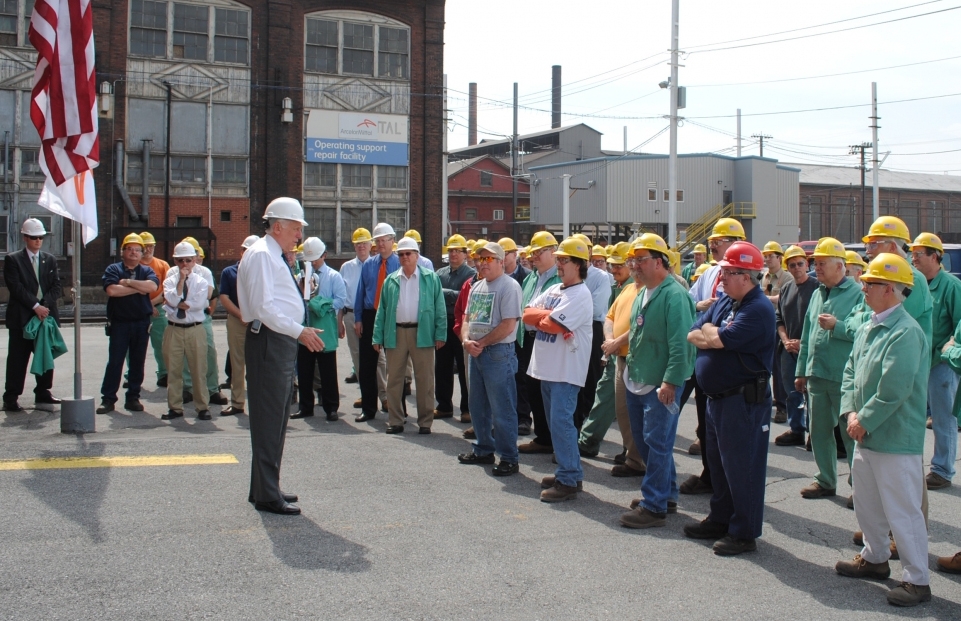
Steny Hoyer (MD-5), along with Tim Holden (D-PA), discusses the ‘Make It In America’ agenda with employees of the ArcelorMittal steel factory in Steelton, Pennsylvania. (April 2011)
“This same sentiment was expressed in our meetings with the National Association of Manufacturing, which has been a strong advocate for bringing government and the private sector into agreement when it comes to boosting competitiveness.
“Two months ago, we saw a glimpse of how things ought to be when 147 House Republicans joined with a unanimous Democratic caucus to reauthorize the Export-Import Bank. This was a major component of our Make It In America plan, and it will help us fulfill President Obama’s objective of doubling American exports by 2015. However, the fact that a piece of legislation that used to move with nearly unanimous support took so much effort ought to concern us all.
“I hope those who came together in a spirit of bipartisanship that day will continue doing so to pass more Make It In America bills.
“That’s why I’m suggesting today a series of additional steps Congress can take right away. Democrats are putting forward several new proposals as part of our Make It In America plan and are calling on the House leadership to work with us this summer to act on them.
“First is the Bring Jobs Home Act. Sponsored by Rep. Bill Pascrell, it would eliminate the tax deduction for moving expenses for companies shipping jobs overseas. It would further provide a new credit for companies moving jobs back home.
“Congress should pass a Miscellaneous Tariff Bill to eliminate duties on certain products not produced in the United States, particularly raw materials and intermediate inputs that are used by our manufacturers. This will reduce their production costs and help make these manufacturers more competitive.
“The third and fourth new items being added to our Make It In America plan will help us close the skills gap and connect more out-of-work Americans with secure and well paying manufacturing jobs. One of them is a reauthorization and modernization of the Workforce Investment Act, sponsored by Rep. John Tierney. The other is Rep. Kathy Hochul’s bill that grants a $1,000 per-student tax credit to employers that partner with colleges and trade schools in order to provide skills training.
“In March, President Obama proposed a National Network for Manufacturing Innovation that will bring manufacturers, academia, and government together to create an innovation infrastructure that will accelerate the development manufacturing technologies. In the coming weeks, we will be introducing legislation to implement this proposal.
“As much as we ought to be investing in an innovation network, we must also invest in improving the physical network of roads, bridges, rails, and ports that enable our manufacturers to obtain raw materials and get their products to market. Rep. Albio Sires’ FREIGHT Act will lead to the development of a National Freight Strategic Transportation Plan to assess the needs of our aging freight networks and create a National Freight Infrastructure Investment Grant program. Major shipping canals are being widened, and, as ships are built larger, we need ports and freight rail facilities that can accommodate them.
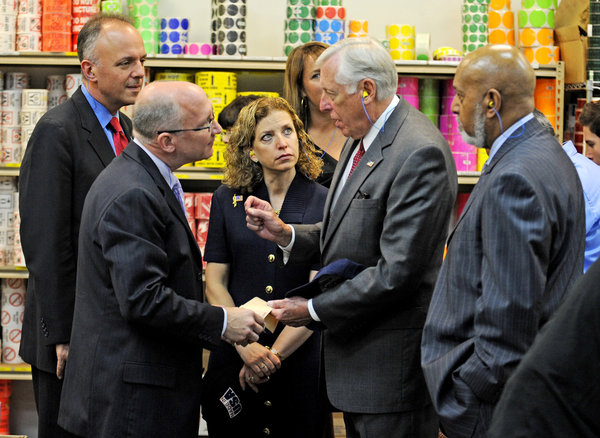
Steny Hoyer discusses the ‘Make It In America’ agenda with David Perlman, owner of A&M Tape & Packaging in Sunrise, Florida, along with Democratic leaders Ted Deutch (FL-19), Debbie Wasserman Schultz (FL-20) and Alcee Hastings (FL-23). (May 2012)
“And we must make sure that other countries are playing fair and abiding by trade rules. The ENFORCE Act, a bipartisan bill sponsored by Reps. Linda Sanchez and Billy Long, will establish new procedures for investigating claims against foreign manufacturers for evading anti-dumping and countervailing duty orders. It will help us better enforce trade rules and prevent illegal imports.
“In addition to these measures, the House Energy and Commerce Committee came together in a bipartisan vote last month to send to the House Floor a Make It In America bill sponsored by Rep. Dan Lipinski – the American Manufacturing Competitiveness Act. It calls for the development of a national manufacturing strategy by bringing the public and private sectors together to create a comprehensive plan of action. Any business executive will tell you that you ought to have a carefully crafted strategy before undertaking a large project, so I hope the full House will pass Rep. Lipinski’s bill quickly.
“Taken together, along with the other Make It In America legislation we’ve already introduced, these measures will help us invest in out-educating, out-innovating, and out-building our competitors.
“All indicators agree that manufacturing is ready to take off and carry other sectors of our economy with it. It just needs a good push. Make It In America is just the push our manufacturing sector needs, and it is a strategy all Americans can agree on.
“Of course, as I have said many times before, Congress must work concurrently on achieving a big solution to deficits this year if we are going to afford the investments contained in our Make It In America plan. Our continued competitiveness is dependent on Congress and our country acting with courage and determination to address our fiscal challenges, namely the fiscal cliff looming at the end of this year.
“That’s why I have continued to call on Congress to ‘go big’ with a balanced solution before the year is over. We will have to address deficits due to the approaching onset of sequestration, and a number of items are scheduled to expire, such as the ’01 and ’03 tax cuts, which include capital gains and dividends; as well as the estate tax and the Alternative Minimum Tax. We will have to put everything on the table and make strategic choices about our fiscal future. If we do not address this challenge, the confidence essential to economic growth will not be present.
“We in America have always been a solutions-driven people. Pragmatism, entrepreneurship, and common sense carried us across this vast continent. They drove us forward to achieve in science and medicine. They carried us to the moon and safely to back to Earth.
“We must embrace them once more. We must strive for solutions to the challenges of our time. If we can achieve them, their effects will not be felt only in our time.
“It is now up to us to surmount the challenges we face, and to do so we must, as a nation, recommit ourselves to the pursuit of a solutions-driven politics. One that will enable us to achieve what Americans deserve – solutions that will help more of our businesses and our people ‘Make It In America.’
“Only by working together – not as Democrats or Republicans, but as Americans – can we rise to meet our challenges. I know we can do it, because we have in the past. And we must do so again.”
